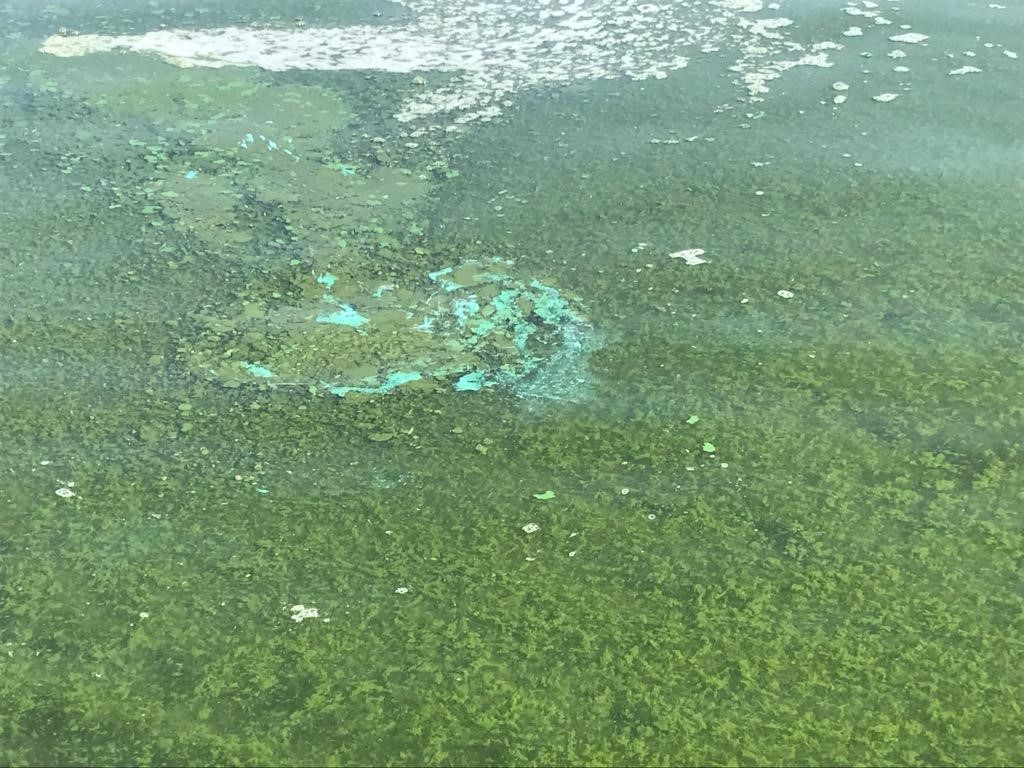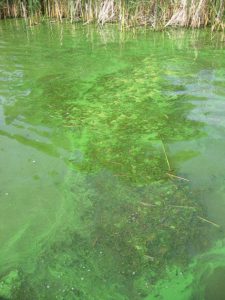As temperatures warm during summer, Idahoans flock to the shores of our rivers, lakes, and reservoirs. Whether it’s boating, swimming, fishing, picnicking with family and friends, or just walking along the banks – Idaho’s waters provide a respite from the heat and a chance to cool our toes. With over 2,000 lakes and 93,000 miles of rivers and streams in the Gem State, Idahoans have a lot of options.
Unfortunately, not all water bodies are safe for swimming due to outbreaks of toxic algae.
What is toxic algae?
Blue-green algae or cyanobacteria naturally occur at background levels in many freshwater ecosystems. But when conditions are right (or wrong…), populations of toxic algae have the potential to explode, producing potentially fatal cyanotoxins that can cause severe illness or death from direct contact, ingestion, and even exposure to wind-borne spray. Symptoms can include abdominal pain, vomiting, blistering around the mouth, fever, headache, diarrhea, cough, hives, rashes, and respiratory paralysis, and even lead to death. Dogs, cattle, and other livestock can be especially susceptible to toxic algae.

How do these outbreaks occur?
Outbreaks generally occur when there is a combination of high water temperatures and excessive phosphorus and nitrogen, which feed these bacteria. Nitrogen and phosphorus pollution often result from wastewater systems and treatment plants, overfertilization of crops and lawns that drain to surface or groundwater, industrial discharges, and beef and dairy feedlots.
But high water temperatures are not always a prerequisite for toxic algae. In June 2022, the presence of thick mats of greenish algae in Lake Cascade caused concern when water temperatures were still down around 60 degrees, when outbreaks generally do not occur. While monitoring determined that the levels of cyanotoxins were below the level required to issue a Health Advisory, Central District Health and Department of Environmental Quality urged caution and encouraged visitors to be vigilant and avoid areas where algae was present.
What does an algae outbreak look like?
Since Health Districts and other partners rely upon citizen reports to monitor potential algae outbreaks, it’s important to know what one looks like. Cyanobacteria can vary in its appearance, often it looks bright green (like pea soup), but can range in color from blue to brown, red, or even white. Outbreaks can look like grass clippings, spilled paint, foam, or can appear mat-like, forming a dense surface scum.
If you notice a suspected outbreak, it’s important to stay out of the water. If you, your pets, or other individuals have been in contact with the water, seek out clean water to wash off. Watch closely for any potential symptoms listed above and seek prompt medical attention if you develop any.

Who should I contact if I suspect an algae outbreak?
Notify the DEQ and the local Public Health District promptly to instigate monitoring efforts to determine whether an outbreak is present and a Health Advisory is warranted.
DEQ can be reached at 208-378-0502, via email, or online. Make sure to include photos, descriptions, and locations to ensure appropriate follow up and testing.
Idaho is divided into 7 Health Districts. For information on locations and contacts, click here.
Information about active health advisories and potential algae outbreaks is available online through the Department of Health and Welfare and Department of Environmental Quality (DEQ) pages dedicated to safe recreation and toxic algae.
Where have past algae outbreaks occurred?
Locations of past outbreaks are a good indicator for areas to be especially cautious. The locations for 2021 Health Advisories included: Hells Canyon, Brownlee, Salmon Falls Creek, Upper Island Park, and Cascade Reservoirs, as well as Lowell, Solomon, Henry’s, Fernan, Hayden, Spirit, Mann, Cave, and Hauser Lakes. Other water bodies included Hordemann Pond and portions of Lake Pend Oreille and the Priest Lake Outlet. Prior outbreaks also occurred in Momon, Oxbow, Camas, Little Camas, Mountain Home, Cedar Creek, Thorn Creek, Blacks Creek, and Spring Valley Reservoirs, as well as Avondale, Black, Cocolalla, Winchester, Silver, Round and Upper Twin Lakes.
What else can be done about toxic algae?
While we appreciate the efforts by DEQ, public health districts, and the Dept. of Health and Welfare, more needs to be done. Currently, no state or local agencies receive any funding to work on toxic algae issues, monitoring, or notification.
Based on threats to public and environmental health, Governor Little and the Idaho Legislature should allocate dedicated funding to the DEQ and Dept. of Health and Welfare to proactively monitor for toxic algae, ensure a robust notification process is in place, and increase education and prevention of toxic algae.
Take action below and let Idaho leaders know that you want funding allocated toward this public health hazard. After all, we all benefit from clean water!

